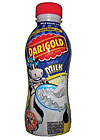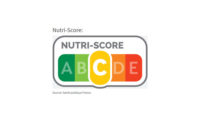
Dairy processors want labels that run efficiently on their labeling system, says Terry Copenhaver, marketing manager for Reynolds Flexible Packaging, Richmond, Va. “They also want labels that have shelf impact with high-impact graphics, such as shrink-sleeve labels, for single-serve dairy products. The market is very competitive and shrink labels differentiate single-serve milk products like no other labels,” Copenhaver says. “They assist dairy processors with brand/SKU differentiation and rapid changes or launch of new SKUs to pursue narrower market segments.”
New technology is being generated by machinery manufacturers to develop high-speed lines with the utilization of state-of-the-art processes that never before were available, says Ron Giordano, chairman and chief executive officer of H.S. Crocker, a Huntley, Ill.-based provider of food, dairy and specialty printing of shrink sleeves and packaging including cartons and cups.
“In today’s world, processors are expecting – and deservedly so – speed, accuracy and reliability of the product they receive from their vendors,” Giordano says. “A lot of pressure is placed upon processors to meet or exceed line speed and take as much cost out of their product so they remain competitive in today’s marketplace.”
Speed is a need echoed by Doug Buske, director of machine sales for Hartland, Wis.-based QLC Inc., an equipment dealer for Label-Aire, Fullerton, Calif. “We are seeing more and more dairies going to fill at higher speeds. As more dairies are expanding into juices, their speeds are increasing. Speeds of 180 to 200 bottles per minute are becoming a common request,” Buske says. “At those speeds, they never want to shut down the production line. So redundant labeling systems are installed to keep the machines running 100 percent of the time.”
Harrison Chien, vice president of sales for St. Louis-based Label-Aire dealer U.S. Tape and Label, says labeling equipment has to help maximize throughput and improve overall equipment effectiveness. “The notion that a label is just a label is starting to fall by the wayside as we are seeing more appealing graphics that standout to consumers,” Chien says. “One way to maximize efficiencies is to reduce downtime on the machines and speed up the lines. Larger rolls of labels are being produced and the needs for larger roll capacity systems are needed. Auto splicers and labelers capable of 20-inch rolls are available, as well as new higher-speed labelers and product-handling systems.”
Rich Keenan, sales manager at PDC International Corp., Norwalk, Conn., says shrink-sleeve labeling equipment must have a seamless transition, not only from size to size but also when there are several shrink-sleeve label suppliers. “Today, with shorter production runs, an operator must be able to complete a changeover in minimal time and guesswork,” he says. “PDC has standardized tool-less changeover on all models as well, with pin-point settings. With these standard features, you’re able to start production, no matter who changes over your labeler.”
And with the price of, well, almost everything on the rise, processors are looking to reduce any costs they can. “Reynolds Flexible Packaging can offer PETG at a thinner gauge or OPS shrink labels through Reynolds KAMA, which have a 25 percent yield advantage over PETG and PVC,” Copenhaver says. “In addition, Reynolds has just installed a state-of-the-art flexographic printing press that allows us to supply high-quality printing for short runs more cost-efficiently.”
Sustaining labels
“Sustainability has become an increasing portion of every system in the packaging industry today,” Giordano says. “Machines must now be able to operate with current material as well as new materials without costly change parts and change over delays. The new products must be able to meet, exceed and be virtually invisible to the equipment it is running on.”That extends to shrink labels. “Reynolds OPS shrink labels require less energy to produce due to the higher yield,” Copenhaver says. “In addition, they can be sent through the recycling stream without contaminating that stream like other materials can.”
Jon Knight, director of packaging, label and technical business for Treofan America, Winston-Salem, N.C., says “downgauging” or “lightweighting” of labels addresses not only demands for lower cost but also sustainability. “In the case of ice cream tubs, the switch from paper/PE containers with paper/PP lids to PP (polypropylene) containers and lids with PP in-mold labels creates a fully recyclable package,” he says. “This is not the case with the traditional ice cream tubs. Wells’ Dairy has been an early adopter of this new packaging/labeling technology.”
And like alternative fuels, alternative materials are all the rage, with corn-based plastic leading the charge. Paul Pritchett, sales and marketing manager for Atlanta-based Seal-It, a division of Printpack Inc., notes his company is one of only a few shrink-sleeve label suppliers that have a co-branding for EarthFirst film, made from plants. “This film provides an alternative to traditional petroleum-based products,” he says. “It’s more stable at higher temperatures than other shrink films and takes less energy and time in the heat tunnels to shrink. It also machines well, prints well and shrinks as well as, if not better than, PETG.”
Major retailers also have influenced development. “Knowing Wal-Mart’s scorecard program, our plan was to be more proactive, not only on the labeling equipment but our manufacturing processes as well,” Keenan says. PDC’s current processes include shrink-sleeve and stretch-label equipment able to run 27 micron, then the standard 50 micron; energy-efficient motors; tunnels that recirculate hot air; eliminating compressed air on all labeling equipment; and power-saving features. The company continues to work with suppliers and customers on solutions and is down-gauging material across all its models.
Food safety
Labeling systems continue to offer consumers a sense of food security. “We see many customers using the shrink labels to extend up over the closure for tamper evidence,” Copenhaver says. “In addition, Reynolds is offering an added feature in its Smart Peel tamper-evident band, a patented product that allows the consumer to lift and pull for easy release of the tamper band in place of perforations.”Pritchett says Seal-It sells billions of tamper-evident bands to dairy processors who are concerned about food safety. “The printed bands enhance the look of the package as well as providing a clearly visible sign to the consumer that the package has not been tampered with,” he says. “In addition, we offer an easier-to-open tamper-evident band, so no more struggling or scissors required to get it open.”
But food safety where labels are concerned has expanded beyond tamper evidence. Kendal Malstrom, vice president of sales for Integrated Packaging Machinery, Comstock Park, Mich., says he’s noticed an overwhelming response to label verification. “Many dairies have had issues with mislabeled or unlabeled product accidentally being released to the market. This is due to operator error or not having a ‘double check’ system on their filling lines,” he says. “IPM has developed, at a request of our customers, a label verification system that is designed for the harsh, wet dairy environment. These vision systems enable proper label placement, confirmation of correct labels front and back, and date-code verification, as well as other available features like fill level and cap placement.”
Around the corner
“I believe the next big thing will be the adaption of security features into all labels, lidding and labeling systems to ensure metal detection as well as identifying the product and manufacturing point,” Giordano says.Buske says RFID will continue to develop. “Even though the big push has subsided, we still believe it will be a big area of growth for labeling – not so much encoding on the labelers but to apply the already encoded tags will still be a big part of our growth for 2009,” he says.
New high-speed rotary systems will create more production efficiencies, Chien says.
“These systems have multiple heads that will label products at much higher speeds than what is currently in most processors today,” he says.
Malstrom says IPM has had success with its new label verification system. “We believe the largest success of this product is due to the ease of operation. The PC program is extremely operator-friendly,” he says. “Simply touch the screen of the label you wish to run, enter the date and hit enter, and the system automatically will confirm each container that passes down the conveyor system.”
PDC’s Keenan adds: “What we see as the ‘next big thing’ coming is barrier shrink sleeves for light, moisture, oxygen and O2, which will help with extending shelf life and lightweight (down-gauge) containers.”
Reynolds has introduced its new family of Conceal barrier shrink labels that claim to block 100 percent of UV light and can block visible light up to 99 percent. “This will allow processors to eliminate the cost of multi-layer or pigmented bottles for light block,” Copenhaver says. “In addition, high shrink (less than 50 percent) roll-on, shrink-on (ROSO) labels with Reynolds OPS are now available. With recent developments of ROSO application equipment to handle this amount of shrink, processors can install ROSO systems which can run at higher speeds with lower costs than seamed shrink labels. Some existing roll-fed equipment can be modified to handle the high-shrink ROSO labels, enabling companies to modify the shape of their containers for maximum shelf appeal.”
Ultimately, a label’s primary purpose will continue to be enhanced. “Graphics will continue to carry a lot of emphasis in the future,” Pritchett says, “with different brands trying to out do each other to get the consumer’s attention and to differentiate at retail.”
Extras
H.S. Crocker Co. Inc. www.hscrocker.comIntegrated
Packaging Machinery www.callipm.com
Label-Aire Inc. www.label-aire.com
QLC Inc. (Label-Aire authorized distributor) www.qlc-labeling.com
US Tape & Label (Label-Aire authorized distributor) www.ustl.com
PDC International Corp. www.pdc-corp.com
Reynolds Flexible Packaging www.reynoldsflexpack.com
Seal-It, a Division of Printpack www.printpack.com
Treofan America www.treofan.com
